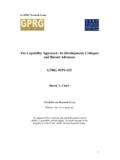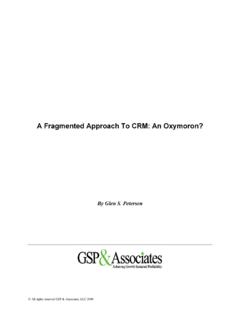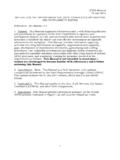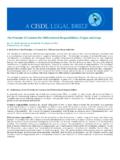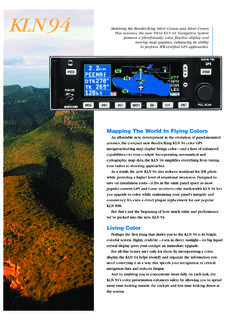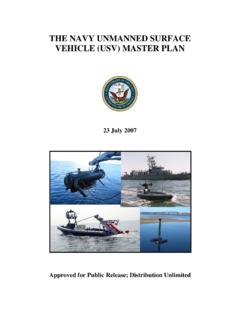Transcription of Model risk management for insurers - EY
1 InsuranceModel risk management for insurersLessons learned1| Model risk management for insurers Lessons learnedInsurance companies use complex models to support almost all critical business decisions. However, models can only estimate future results, and thus they will never produce answers that are 100% accurate. The reliability of results can also be affected by human error, including design flaws, incorrect calculations, out-of-date parameters, misunderstood or poorly communicated assumptions and results, poor data and the inappropriate application of a models introduce risks at all insurance organizations and should be addressed as part of a comprehensive risk management program to protect an organization s financial strength and reputation. Much of the activity underway to manage Model risk in the US is in response to the joint guidance from the Office of the Comptroller of the Currency (OCC) and the Federal Reserve Board: Supervisory Guidance on Model Risk management (SR 11-7/OCC 2011-12).
2 1 Banks, insurers that own banks and insurers designated systemically important financial institutions (SIFIs) will be held to the standards in that guidance. These standards are also establishing leading practices for a Model risk management capability for the broader insurance information on Model risk management and validation that directly applies to insurers comes from Solvency II in Europe and the 2012 North American CRO Council article on applying Model validation principles to risk and capital Together, these sources of guidance provide a good starting point for insurers , but they focus only on capital models and do not address a comprehensive Model risk management the past several years, EY has helped several large insurers build the capabilities for managing the risks inherent in using financial models from establishing governance to shaping policy to helping with This article identifies key lessons learned.
3 Including specific challenges and practical solutions to those challenges, that should help other insurers as they develop their own Model risk management risk management for insurers Lessons learned | Model risk management is not a new concept. Testing and validating the calculation accuracy are vital activities in the creation and ongoing use of a Model . What insurers need now is a more holistic approach to Model risk management , one that considers and mitigates the risks that can arise throughout the life cycle of a has established a framework for managing the risks arising from the use of financial models (see Figure 1).In the Model risk framework, roles and responsibilities are aligned with the three lines of defense used to manage risk throughout the organization. It is important to define the allocation of responsibilities across and within these three groups as seen in Figure Model risk management framework addresses risks in the aggregate and individually.
4 To apply this framework, insurers should factor in the size and complexity of the institution, as well as the scope and materiality of a specific Model , to see that activities meet the organization s needs without becoming too burdensome. Additionally, defined procedures and standards must accompany any framework for it to be implemented consistently across the a Model risk management capabilityFigure 1. Model risk management framework First line of defenseModel ownersSecond line of defenseModel governance and validationThird line of defenseInternal auditEnterprise governanceModel review componentsData and IT infrastructureConceptual soundnessModel governanceProcess and controlsIndependent testingBusiness purposePerformance monitoringModel operationModel implementationModel developmentModel change managementModel life cycle3| Model risk management for insurers Lessons learnedLessons learned in establishing a Model risk management capability Through our experience working with insurers to build a Model risk management capability , EY has identified four areas in need of special attention.
5 Addressing the challenges within these areas early on can help prevent more complex problems from arising later in a Model s life definition2 Governance and policy3 Model validation4 Model documentation4In building and maintaining an inventory of models that will be subject to a Model risk management policy, the following considerations can help streamline Model risk management activities once the policy is in Challenge: The definition of Model may inadvertently exclude analysis tools that introduce risk to the organization. EY point of view: The Federal Reserve Board s Supervisory Guidance on Model Risk management states that a Model is a quantitative method, system, or approach that applies statistical, economic, financial, or mathematic theories, techniques, and assumptions to process input data into quantitative estimates.
6 4 Most insurers have found the need to tailor that definition to their organizations. One example of relevance for insurers is that traditional reserve valuation models are often excluded from the Model risk policy. This occurs for valuation models where there is limited or no judgment and the systems are Challenge: The materiality of certain models may change over time. EY point of view: A Model not deemed material today might have less rigorous oversight throughout its life cycle, even as it exposes the company to more risk tomorrow. insurers may need to identify models whose materiality is likely to change over time. These models may need triggers in place to regularly examine their materiality and determine anew the appropriate level of oversight. Some insurers have removed materiality from the risk rating of models to remove the chance of an inaccurate rating and focus instead on how the Model results are used.
7 In those cases, however, specific procedures and timing of Model validation activities may depend on materiality. 1 Model definition2 Governance and policyOften, insurers are eager to jump into validation activities before laying the groundwork for a sound framework. Developing a policy and establishing governance help to ensure that all other activities of Model risk management are followed appropriately and consistently. Considerations for these initial activities include the following or decentralized structure Challenge: Many insurers are unsure of how to organize their Model risk management activities. EY point of view: Either a centralized or decentralized structure may be appropriate. What matters is the clear definition of roles and responsibilities at each of the three lines of defense Model owners, Model governance and validation, and internal audit.
8 Regardless of Model risk management for insurers Lessons learned |structure, the organization needs clear and consistent visibility into its Model risks and the ability to look at the aggregate Model risk for the entire enterprise. While both structures are used, organizations with more mature Model risk management programs have moved to a centralized structure. One additional point is that if the business units within a company are diverse, enterprise standards may need to be translated into guidelines and procedures at the business unit, product and Model skill sets Challenge: Much of the modeling performed at insurance companies requires a specialized set of technical skills, and validation of models requires a different mindset. EY point of view: Given the evolving regulatory environment, many insurance companies are looking to increase staffing to meet finance, risk and actuarial needs.
9 They are finding it difficult to meet those demands and, at the same time, allocate qualified resources to Model risk management activities. Subject-matter specialists who have the background to effectively govern Model risk management are needed. When choosing members of the Model governance committee and defining their roles, their objectivity, independence and skill sets must be considered. Finally, just hiring technically qualified professionals will not automatically result in the appropriate validation skill set. Organizations that wish to have an internal validation unit need to provide adequate training to junior resources to develop their own validation expertise. For validation activities, some organizations use a third party to access qualified, cost-effective resources. Policy effective date Challenge: Many models in use today were developed years ago and may be overlooked when Model risk management activities focus on Model development.
10 EY point of view: Model risk management policies in place at some financial institutions apply to models developed or modified from that point on but not models already in place. This may make sense in an environment where models are frequently created or modified. However, insurance models can stay in place for many years without going through a formal redevelopment cycle. This is particularly true of many actuarial modeling platforms with open code, that get developed outside of a formal environment. A policy that addresses only models moving through a formal development process may leave existing models without appropriate documentation and validation activities. The policy needs to clearly specify that it includes both new and established models in its | Model risk management for insurers Lessons learned3 Model validationManagement expectations Challenge: Senior management and the board of directors may not be aware of the scope and expectations related to the validation of a Model .










